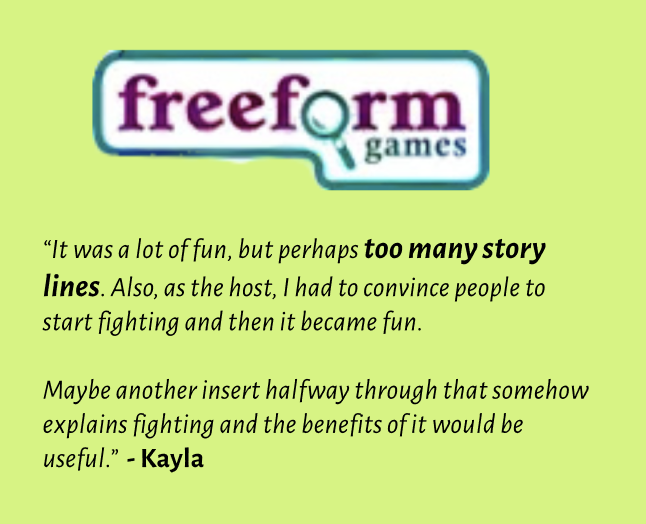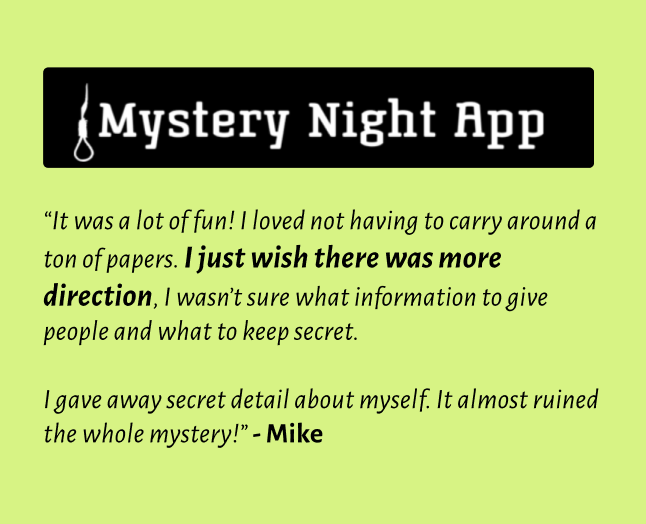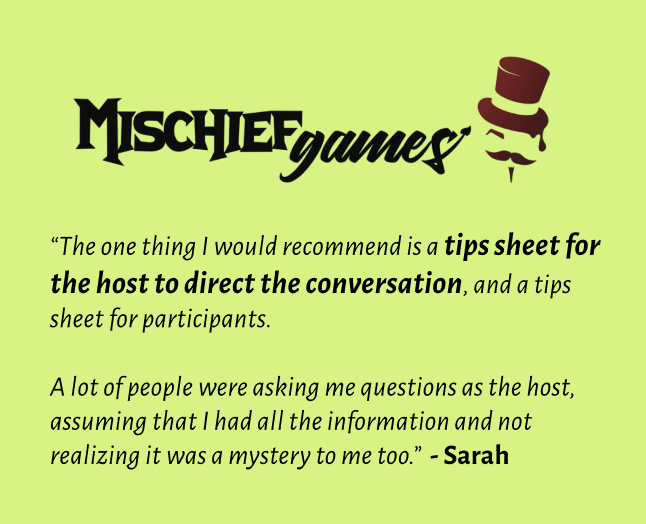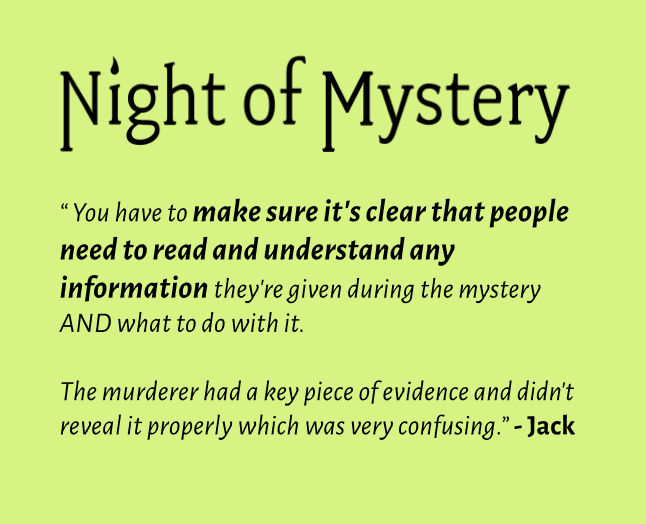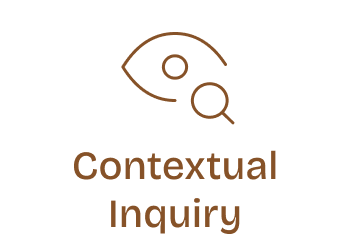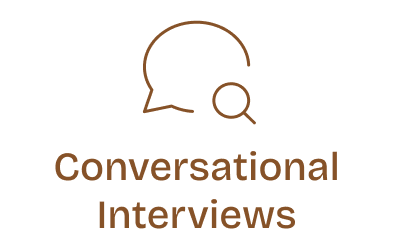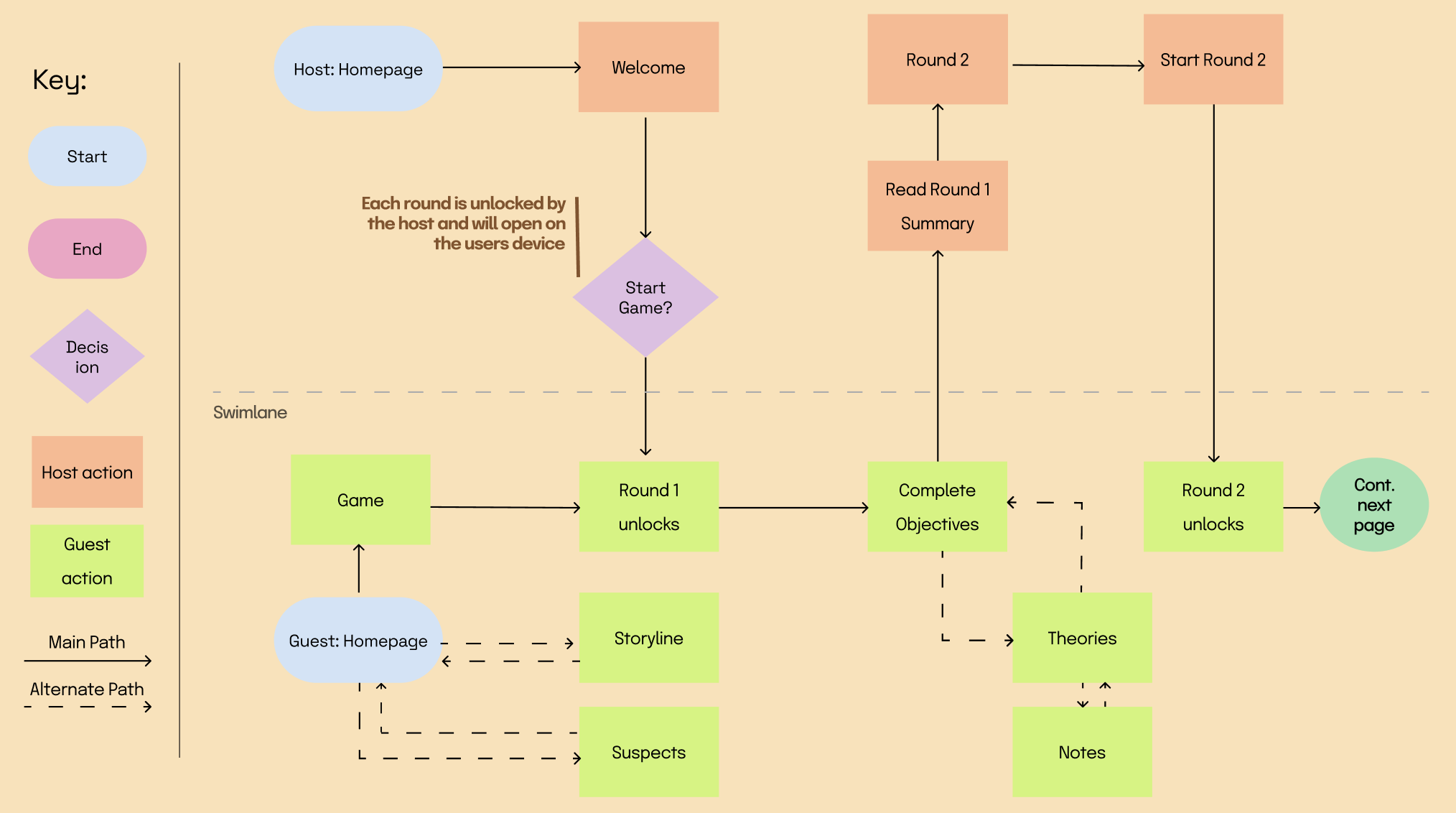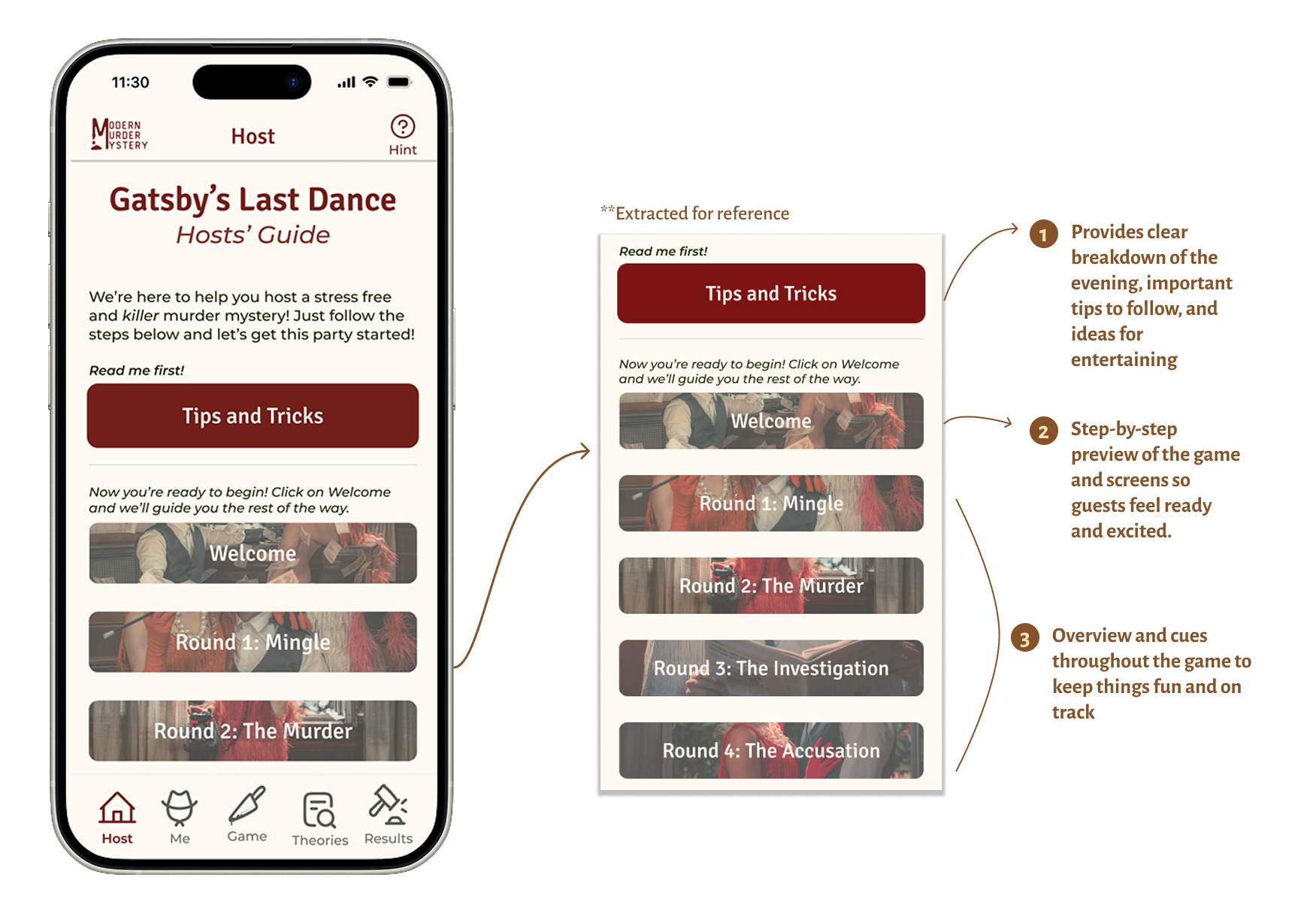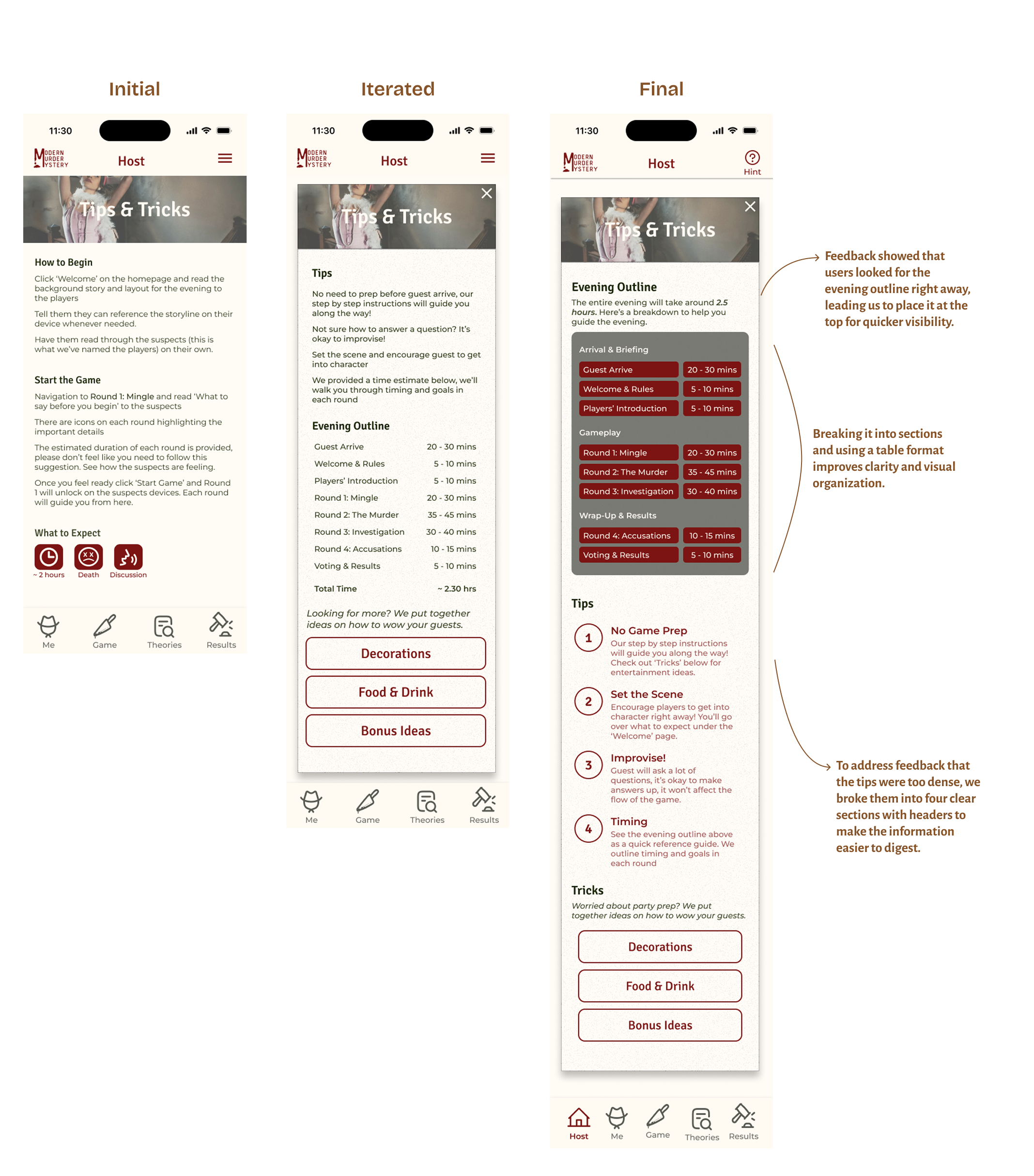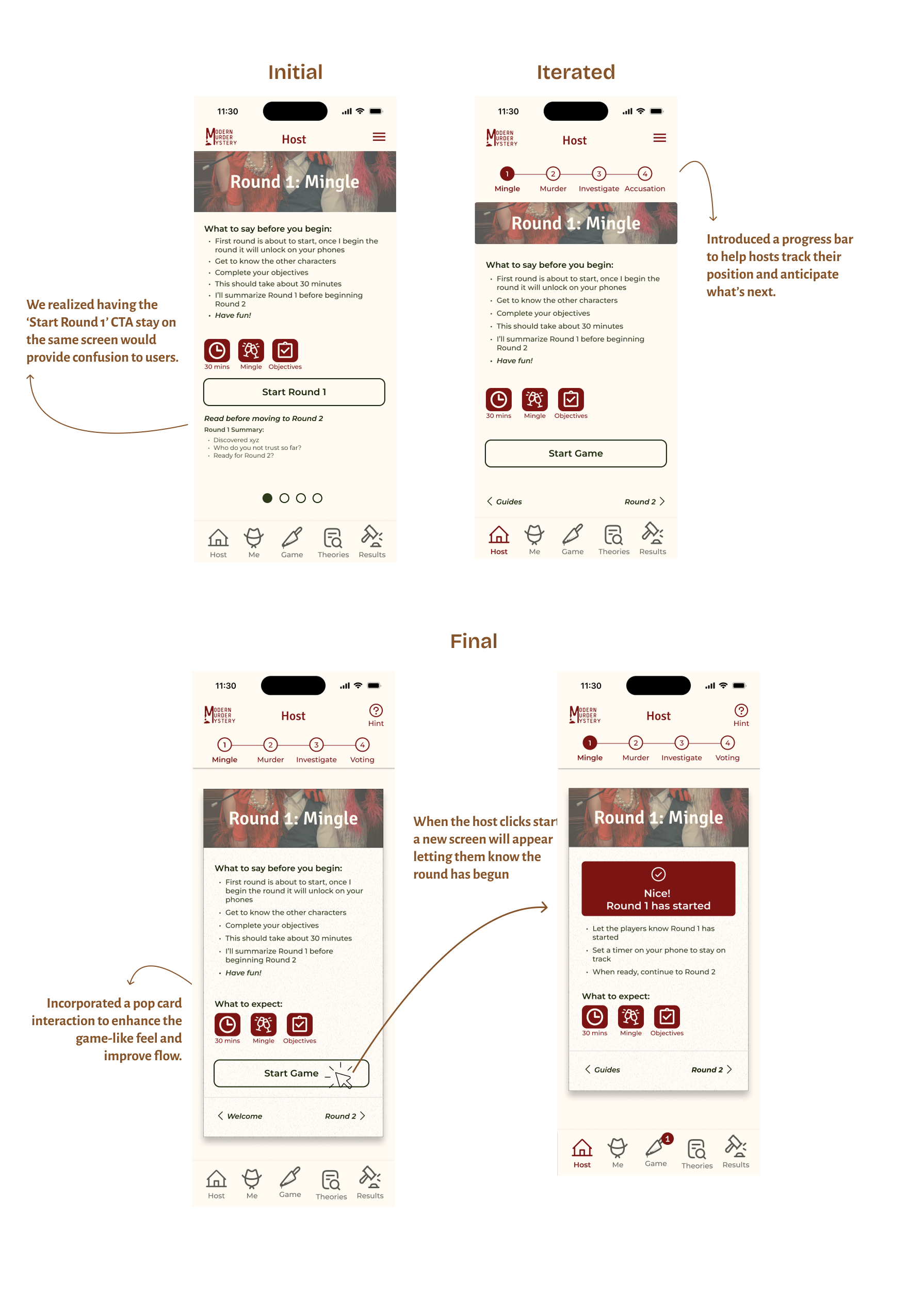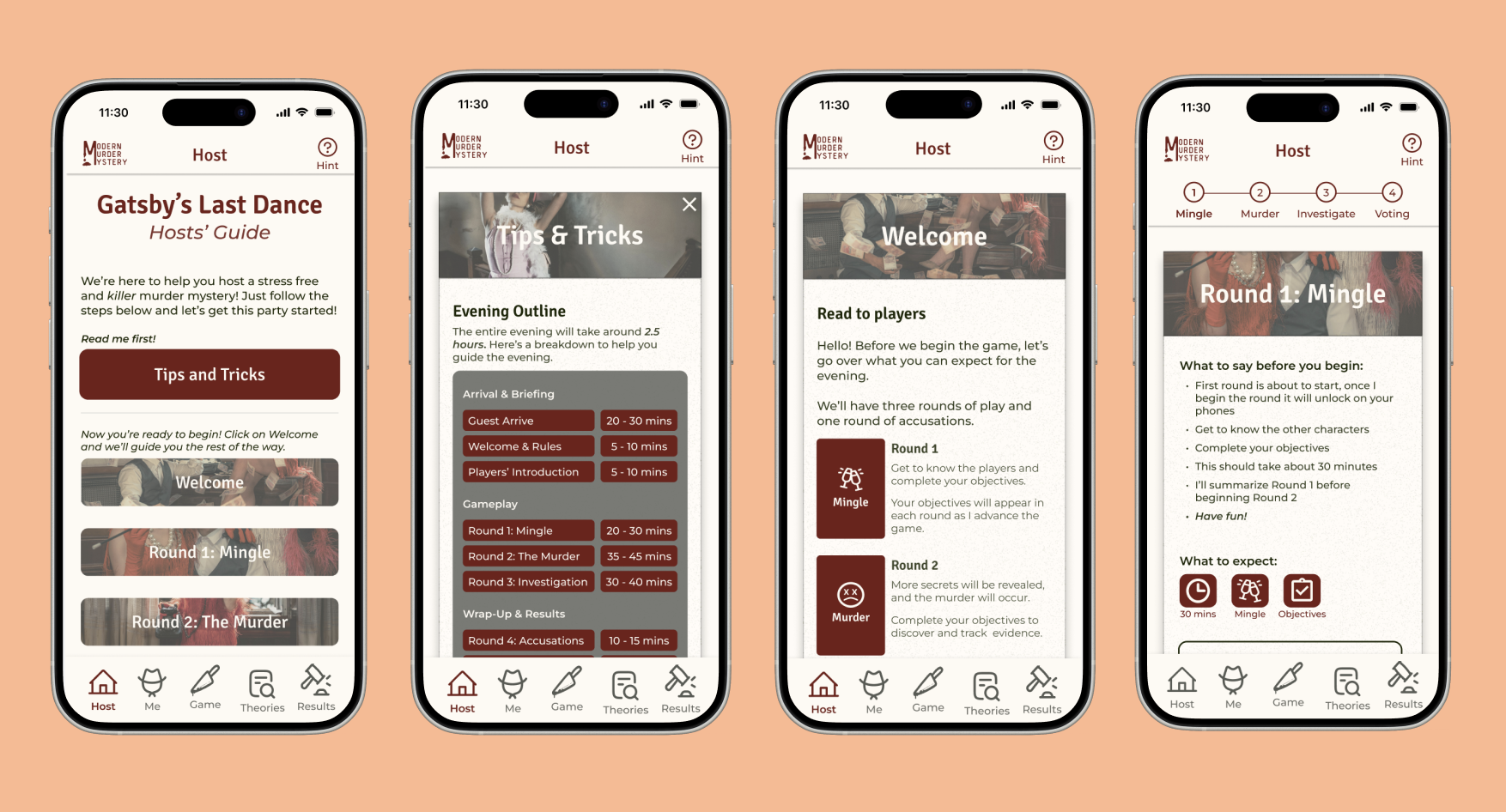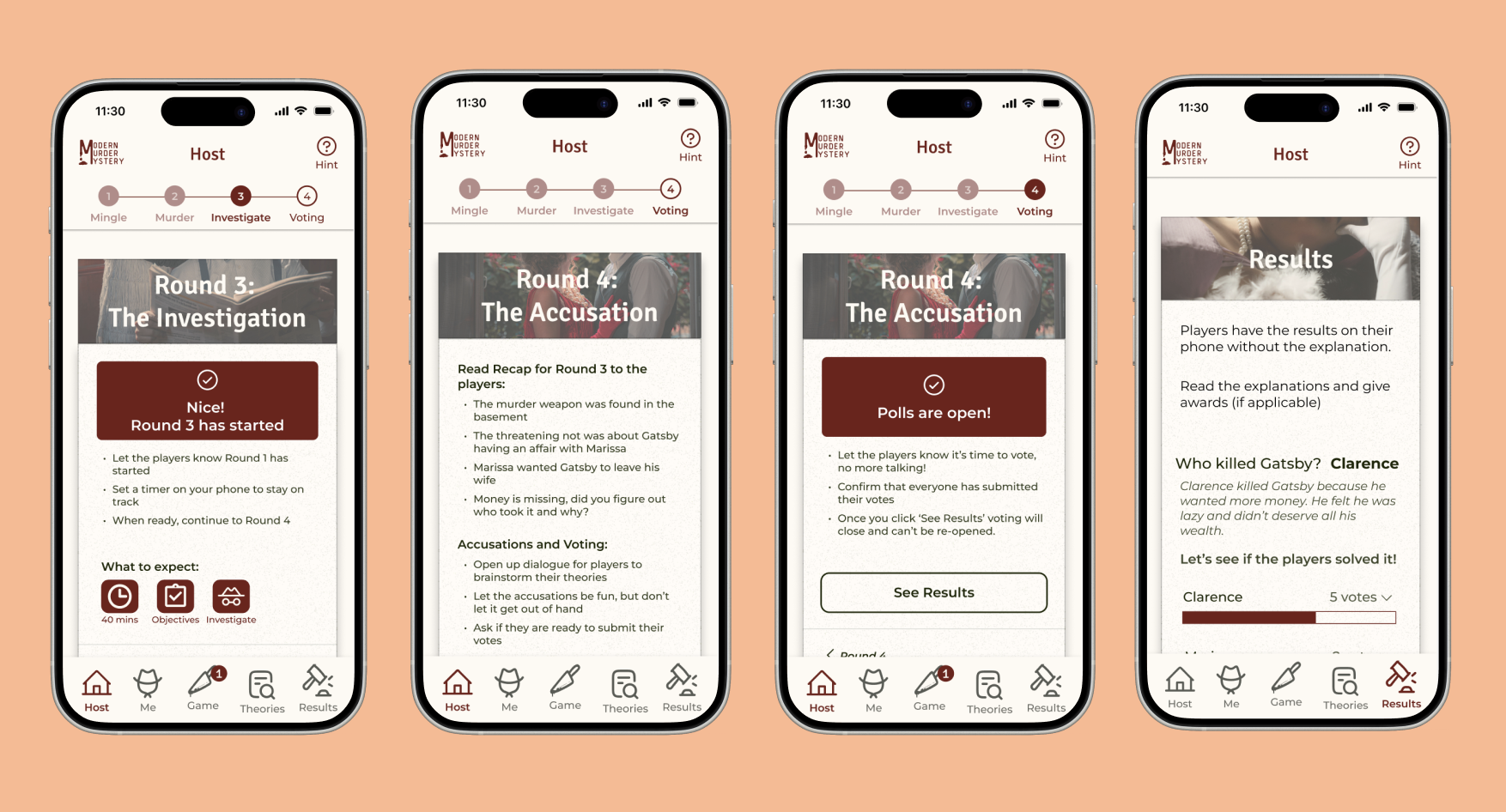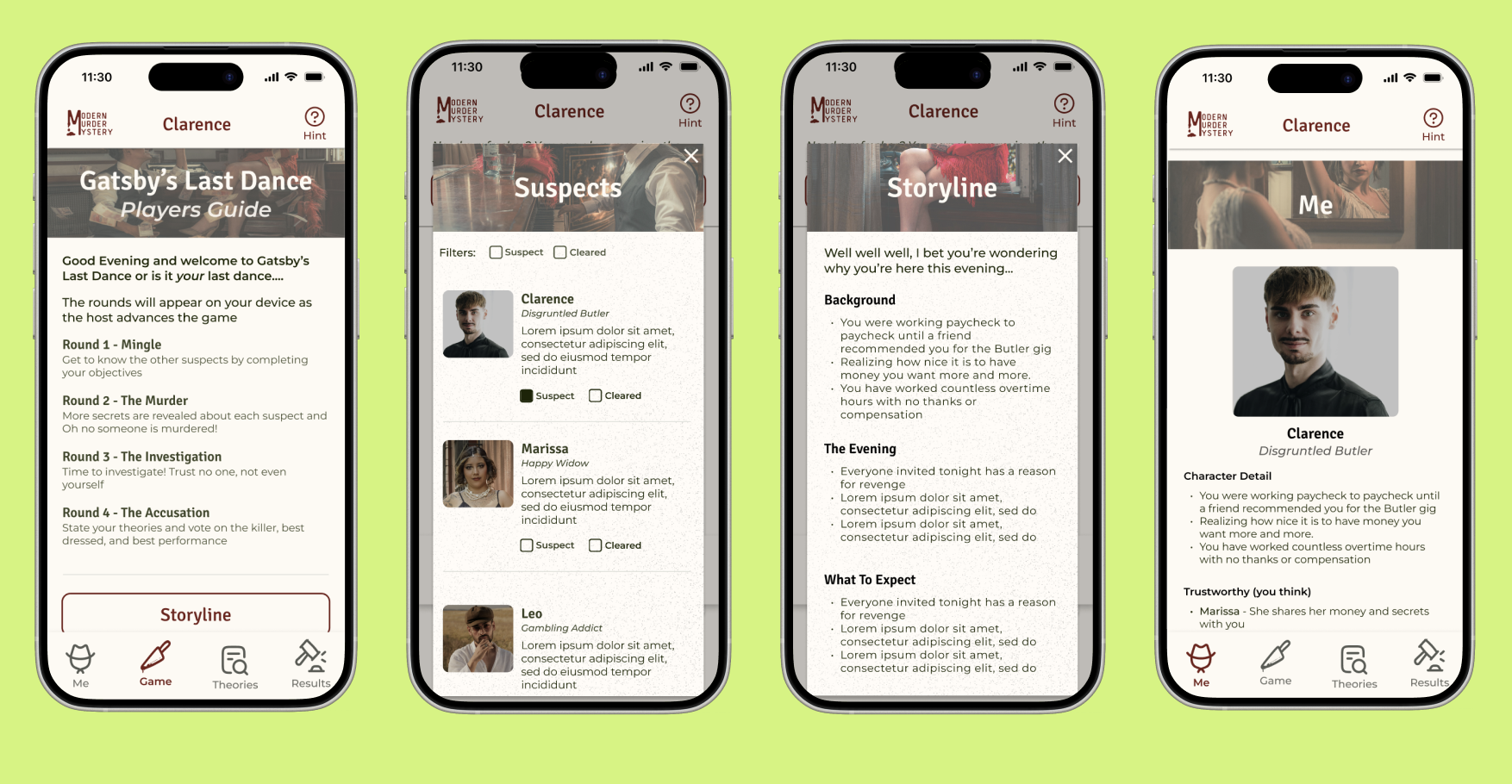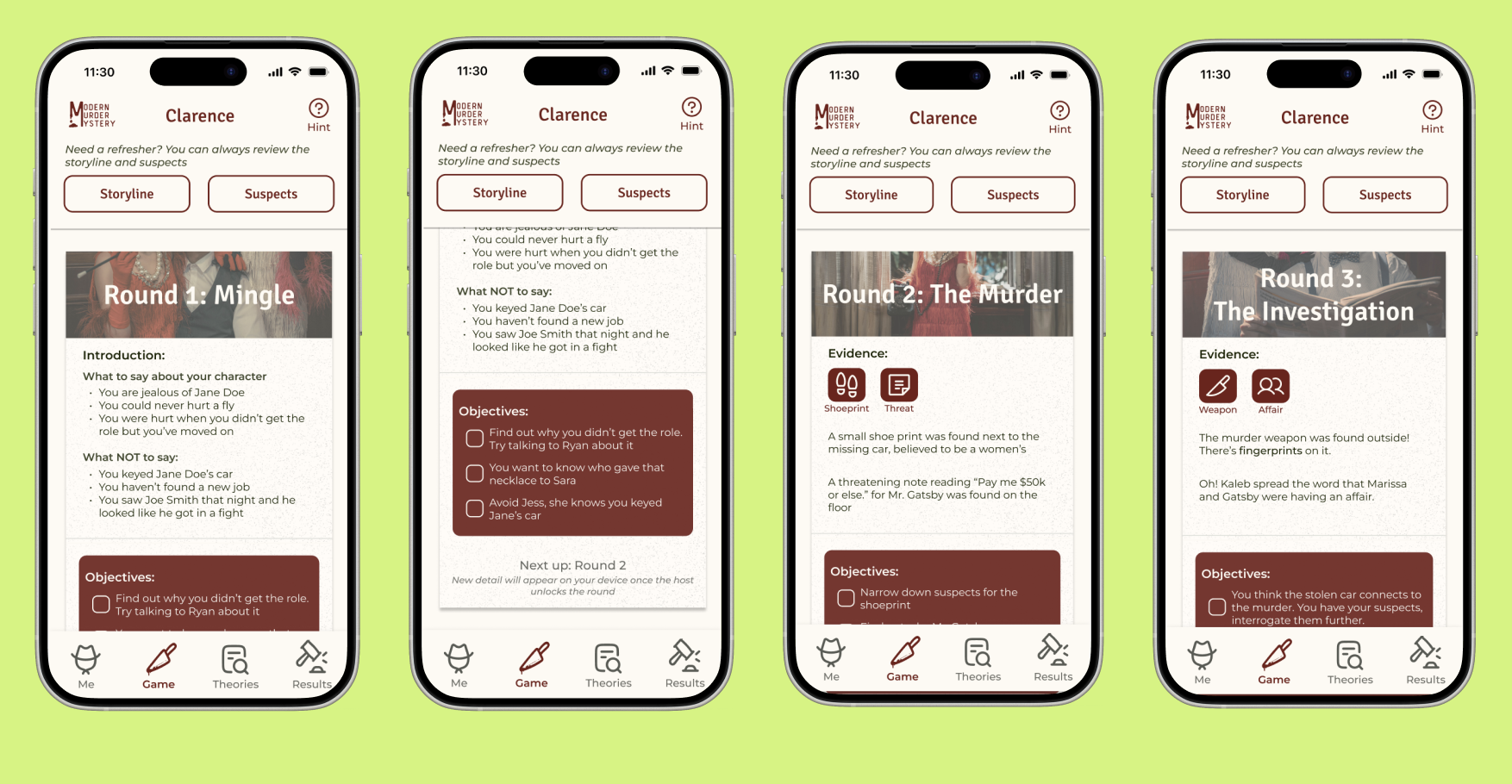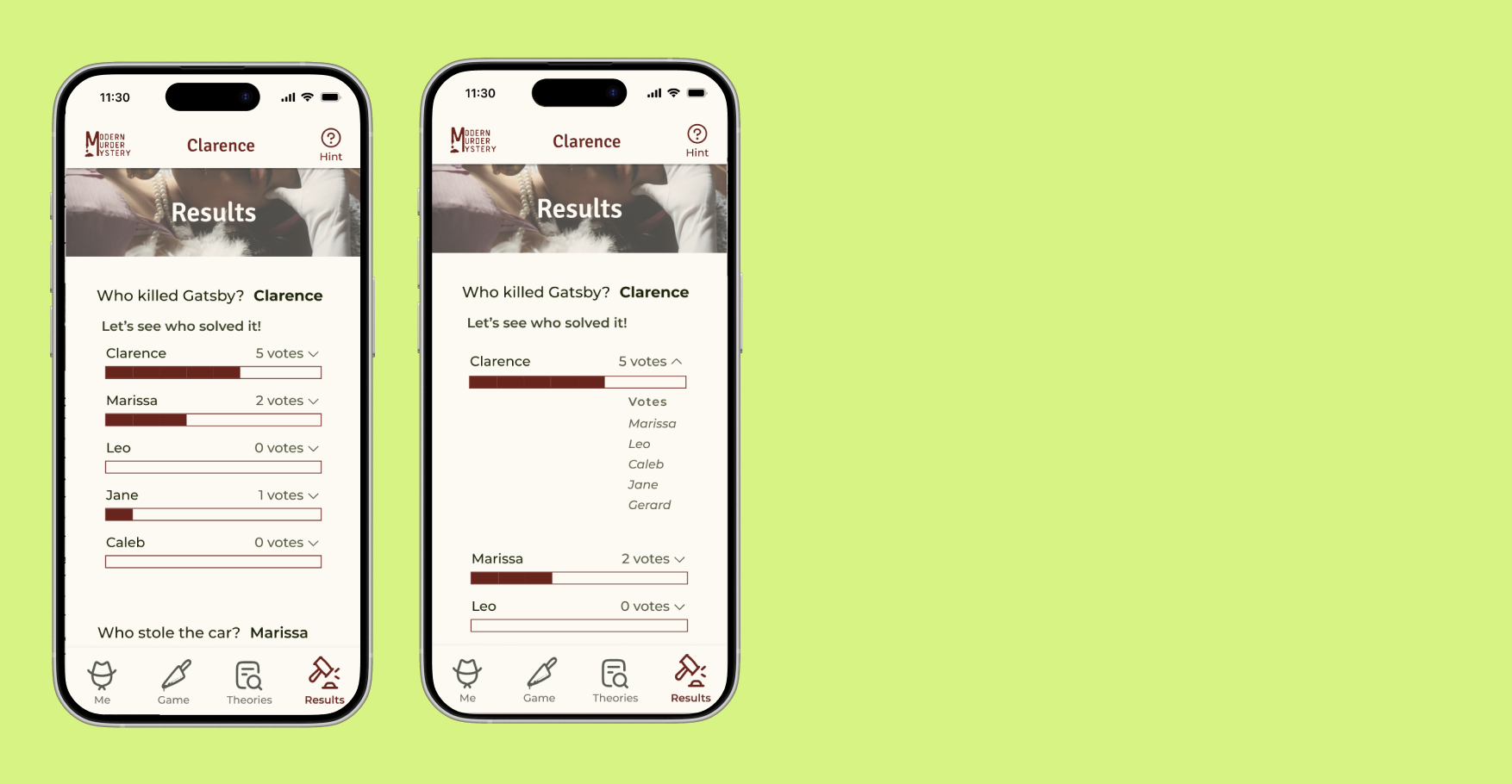Digitizing Murder Mystery Parties
Modern Murder Mystery - Q2 2025 - 6 weeks
My Role
Product Designer / UX Researcher
Team
I’m working with a small team, including a developer and a writer, to build a murder mystery web app designed for 9–12 players. We meet weekly to align on scope, design progress, and development priorities.
Based on user research (outlined below), I created a template for the user interface that’s serving as the foundation for the build. The designs you’ll see reflect our shared direction and serve as key references for development.
Background
Murder mystery parties promise intrigue, laughter, and unforgettable moments—but in reality, they often leave hosts burned out and guests confused.
The current experiences demand hours of preparation from the host:
printing packets
assigning roles
managing timelines
fielding endless questions
The result? A stressed-out host who’s scrambling behind the scenes and an experience that feels chaotic rather than immersive.
This level of disorganization doesn’t just affect the flow of the night—it directly impacts the enjoyment of everyone involved. Guests are left with little direction and unsure how to navigate the evening, leaving the host to juggle even more questions and confusion—further overwhelmed and unable to confidently lead the experience.
As expectations fall flat, enthusiasm fades. Many hosts walk away feeling discouraged, and guests are less likely to attend a murder mystery party again. We're rethinking that experience.
Market Gap
Murder mystery parties lack modern, digital-first solutions. Current offerings rely on outdated, print-based formats that place the burden of planning, organizing, and execution entirely on the host. This creates cognitive overload for the host as they juggle timelines, character roles, and materials, often across hundreds of pages, resulting in decision fatigue before the party even begins.
Discovery
We conducted user interviews, contextual inquiries, and a competitive analysis to uncover user pain points, needs, and expectations—insights that shaped a more focused and efficient product strategy.
Competitor Analysis
I performed a competitor analysis between four Murder Mystery Party companies: Freeform games, Mystery Night App, Mischief games, and Night of Mystery and determined that most companies overwhelm players with excessive information and no guidance, making it difficult to identify what’s actually important for playing the game.
Customer Reviews:
Generative Research
Problem: The effort required to host a murder mystery party is so great, many hosts don’t even get to enjoy the party.
Research Goals/Objectives:
Understand the current state planning process
Identify areas of friction (long taxing manual process, preparation, etc.)
Understand host sentiment towards the planning process and where there is room for improvement
Methodology:
Contextual Inquiry
To better understand user behavior in a realistic setting, we conducted contextual interviews using the Mystery Night web app, a digital version of a traditional murder mystery party.
Goal:
Observe how users engaged with the digital game format
Uncover opportunities to improve the overall experience.
Participants were observed during actual gameplay, allowing us to note moments of confusion, reliance on others for instructions, or disengagement. We paid special attention to the host’s mental load, communication flow among players, and how information was accessed or misunderstood during the game.
After the session, we conducted a structured debrief to capture participants' reflections, frustrations, and suggestions.
By leveraging a live competitor product, we gained valuable insights into user expectations and where the current digital experience fell short—insights that directly informed our design decisions.
Participants: 9 players (8 guest, 1 host) for a Murder Mystery game of 9-12 people
Typical murder mystery parties are made up of groups of friends, often between the ages of 25–40. With that in mind, we intentionally selected a group of nine individuals who already knew each other.
Participants were chosen for their interest in immersive entertainment and their comfort with basic digital tools. This setup allowed us to observe authentic group dynamics and identify real pain points in a natural, party-like environment.
Key friction points uncovered during observation:
Hosts still experience decision fatigue due to disjointed or unintuitive digital tools.
While a digital format reduced setup time compared to traditional paper packets, hosts still encountered confusion and required last-minute clarifications - indicating a need for more intuitive streamlined prep experience.
Social momentum dropped once gameplay began
Players mingled easily at the start but quickly ran out of context-driven prompts or story-based conversation starters—suggesting an opportunity to integrate structured moments that encourage interaction throughout the game.
The current digital experience failed to meet modern usability standards.
Although players preferred using their devices over paper, the existing web app felt outdated, clunky, and hard to navigate—resulting in missed cues and disrupted immersion.
During the debrief we discussed strengths and limitations to the web app version. Overall, players would prefer a digital version and provided insight on areas for improvement.
Participant Feedback
Strengths 💪🏽
Increased efficiency by streamlining how players received information
“It was so nice to have all the detail concise and on my phone, I didn’t have to spend time hiding pages of paper from others.”
Players loved the round of accusations saying it added a level of camaraderie.
“It was so fun to go around and say our ideas, Ryan changed my mind on the murderer.”
Limitations ⚠️
Missing onboarding and clear role instructions led to uncertainty at the start of the experience
“I felt lost when giving my introduction, and then I realized I gave out information I shouldn’t have. That really ruined it!”
No section for note taking, a checklist to mark off objectives, clues, and photos of each character.
“It’d make a mental note about something someone said, then forgot which character they were.”
Conversational Interviews
I conducted semi-structured interviews with five participants to gain insight into the planning and participation experience from multiple perspectives.
Three participants had hosted at least two murder mystery parties, giving us firsthand accounts of the preparation process, pain points, and decision-making responsibilities. The remaining two participants had only attended as guests, offering a view into the player experience, clarity of instructions, and overall engagement.
Interviewing both hosts and guests allowed us to identify distinct usability needs and emotional drivers for each role—ultimately helping us design a more balanced, intuitive experience that supports everyone involved in the game.
Users shared two main frustrations with murder mystery parties: cognitive overload and taxing manual process
All host users found the prep work to be cumbersome
“I spent 8 hours printing, cutting, and organizing all the materials. I had to go to the library twice!”
All users (hosts and guests) found the packets of character detail to be overwhelming.
“I felt like every time someone asked me a question, I had to sift through pages of information to find the answer. It was awkward.”
4 out of 5 users find a storyline with side quests to be more entertaining
“I like when there’s more than just the murder. It makes the murder harder to solve and is so fun. One time I had to stop someone from purchasing nuclear plans, it was intense.”
All guest users noted a strong host who can guide the party is crucial
“My wife is the best host, she keeps everyone organized and improvises with ease. It changes the energy of the evening.”
***There's much more that goes on between research and hi fidelity prototypes. I'm happy to do a deep dive into my process upon request.
Solution
Hosts and guests often feel frustrated by the extensive paper materials and the lack of clear, streamlined guidance in murder mystery parties.
How might we digitize the process to simplify the event, eliminating the need for physical materials, while also providing a more dynamic and interactive experience.
Provides a visual representation of the Host and Guest screen to see how they interact with each other. Actions the host performs, will unlock new information to the users’ device.
User Flow
Key Screens
Since our primary goal is to empower the host, we’re focusing on three impactful screens that best demonstrate that support.
Tips & Tricks Screen: How we got it just right
Welcome Screen: Refined
Rounds: The Evolution
Outcomes
Usability testing revealed the flow is easy to follow while providing key detail.
80% of users said they felt prepared to host a murder mystery party, and felt excited about it.
100% of host said digitizing the experience felt like having a helpful assistant by their side throughout the night.
As an added bonus, the solution also improved the experience for the guest. 86% of guest users found the access to storyline, suspects, recaps, and notes to be very helpful, stating they didn’t feel stressed to remember everything.
Next Steps
We’re currently in the process of writing the storyline for the Modern Murder Mystery web application. Once the narrative is finalized, development of the app will begin.
We’re aiming for a Q4 2025 launch. Reach out for more info if you’re interested!
Complete Experience At a Glance
A quick look at how hosts and guests move through the screens


